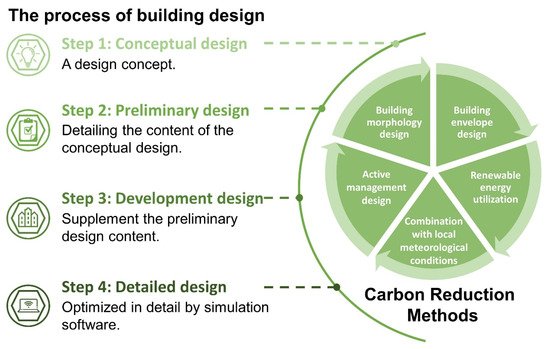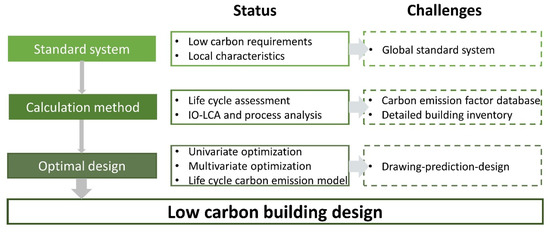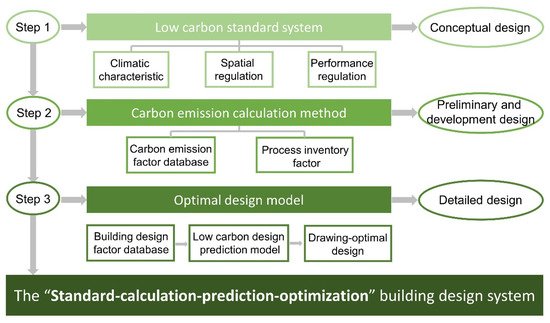1. The Traditional Building Design Process
Figure 1 illustrates the traditional process of building design, namely conceptual design, preliminary design, development design, and detailed design [
29]. Conceptual design is a design concept jointly negotiated by the architect and the project client [
21], which can confirm the building type, volume, functions, and main structural systems. The preliminary design details the content of the conceptual design, such as the layout of the building group, building envelope, structural system, acoustical environment, luminous environment, and air conditioning system. Development design, as a phase to supplement the preliminary design content, mainly covers detailed drawings of the building envelope, detailed layouts of the building, selection of building materials, detailed layouts of the air conditioning and ventilation system [
30], detailed electrical systems, and fire safety. Detailed design is the last phase, in which the development phase design is optimized in detail using simulation software [
29].
Figure 1. The process of building design and methods of carbon reduction.
2. The Status of Low Carbon Building Design
As shown in Figure 2, this paper describes the status of low carbon building design from three aspects, namely (1) the standard system of low carbon building design, (2) the calculation methods of carbon emissions, and (3) the optimal building design.
Figure 2. The statues and challenges of low carbon building design.
(1) The standard system of low carbon building design: Developed countries in North Europe and North America established related policies at an early stage, and have built numerous low-carbon buildings. Europe formulated the European Energy Technology Strategic Plan in 2008 [
45]. The United States developed the Leadership in Energy and Environmental Design (LEED) [
46]. These countries have been leading in the field of green and low carbon buildings, and are further exploring new technologies and new routes for “zero energy and zero carbon” buildings. Green buildings with a low energy consumption and high comfort are emerging gradually.
China’s Ministry of Housing and Urban−Rural Development released the national standard “General Specification for Building Energy Efficiency and Renewable Energy Utilization” to make the calculation of building carbon emissions aiming at “carbon peaking and carbon neutral” a mandatory demand [
47]. “The announcement on the issuance of the implementation plan for the in-depth development of green low-carbon leading action for public institutions to promote carbon peaking” states that the promotion of ultra-low energy buildings and low-carbon buildings should be accelerated and green buildings should be developed. Solar photovoltaic photothermic systems should be vigorously promoted. Photoelectric high-efficiency photovoltaic power generation facilities should be installed, making full use of the suitable site space, such as on building roofs and facades [
48].
Several provinces and cities in China have put forward relevant development plans for low-carbon building design successively. In Shanghai, it is suggested that assembled buildings should be developed as ultra-low energy buildings, which advocate for the use of exterior wall insulation, high-performance exterior windows, and related technological innovation [
49]. Sichuan Province encourages the establishment of a building energy-saving system in accordance with the local climate, humanities, and natural resources [
50,
51], while Yunnan Province mentions similar suggestion [
52]. The Chongqing government has a standard and management system for ultra-low energy consumption buildings, further providing technical support for projects in the design and construction phases [
53].
Currently, there are timely development requirements for low carbon building design in all regions. The building design is a complex issue influenced by climate, humanities, economy, culture, and other factors [
54,
55]. The standard system of low-carbon building design should be improved.
(2) The calculation methods of carbon emissions: Embedded carbon emissions and operational carbon emissions are generated in the life cycle of a building. In the “Standard for building carbon emission calculation” (GB/T 51366-2019) [
56], the operational carbon emission calculation is determined based on the amount of different types of energy consumption and the carbon emission factors. Simulation software, such as Energy Plus, eQuest, and TRNSYS [
26,
40], are used as tools to calculate energy consumption. For the embedded carbon emission, life cycle assessment (LCA) is an internationally and nationally acknowledged method [
24,
57,
58,
59]. Based on LCA, the input−output analysis (IO-LCA) method is widely used around the world [
60,
61,
62]. It can calculate industry-wide carbon emissions by using economic input and output data, without the ability to perform specific calculations and analyses during the detailed building processes. The process analysis method [
63] can overcome the limitations of IO-LCA by means of carbon emission factors for each phase, which can calculate the carbon emissions from the material production, transportation, construction, operation, disassembly, and recycling of buildings [
58,
59]. Specifically, the detailed process inventory for each phase is necessary for the process analysis method.
Carbon emission factors are an essential part of the calculation of embedded and operational carbon. IPCC provides a basic database of carbon emission factors. The database cannot be entirely suitable for all buildings, owing to the complex and diverse building types [
64]. To be specific, more building forms and composites are gradually being proposed to meet the growing needs of high-rise buildings, resulting in carbon emission factors needing to be updated [
18]. Moreover, the sources of carbon emission factors are not uniform, including the basic databases, literature, and standards [
65,
66]. This is an urgent issue that needs to be solved for the establishment of a standardized and comprehensive carbon emission factor database for low carbon building design.
A detailed building inventory is also crucial for the calculation, without carbon emission factors. As the building inventory information can be commonly obtained from engineering drawings, less detailed information is available on the conceptual and preliminary design phases of building design [
67]. Therefore, the carbon emission calculation method should also consider the life cycle process with less inventory information [
68].
(3) The optimal building design: There are three types of the optimization of low carbon building design. The first one is to investigate the impact of different factors in building design on carbon emission or energy saving (univariate optimization). Compared with active means, passive design can effectively reduce energy consumption and carbon emissions. Studies have been carried out on passive design factors for energy saving or low carbon emissions, including green roofs [
69,
70], window-to-wall ratios [
71], and building orientation [
72], which can provide sufficient theoretical support for low carbon and low energy consumption building design. However, strong interactions are exited between different design factors, causing limitations in practical applications for the univariate optimization.
The second is the multi-objective optimization of building design factors. Construction cost and energy consumption are the commonly used objective functions [
73,
74]. Low energy consumption and low carbon building design can be achieved by finding the optimal objective [
17,
27,
75]. However, this refers more to the carbon emissions of operational energy consumption [
28], which are not enough to indicate the actual carbon emission reduction [
76]. Life cycle carbon emissions should be considered in low carbon building design [
77]. Many scholars have conducted research on the life cycle carbon emission calculation model of buildings, which is also the research content of the third type.
3. The Challenges of Low Carbon Building Design
As shown in Figure 2, based on the analysis of the status of the standard system, the calculation method, and the optimal low carbon building design, several challenges in the development of low carbon building design are present.
The first challenge is the lack of a global perspective design standard system. China’s building stock is relatively high, with various climate characteristics [
84], population densities, economic levels, and human characteristics [
54]. There is an urgent need for low-carbon buildings to consider multiple factors and develop novel design approaches for different characteristics [
85], which consider the spatial form of buildings and being low carbon as the common optimization objectives.
The second challenge is the lack of carbon emission calculation methods applicable to the design phase. The existing calculation methods of embedded and operational carbon require a comprehensive database of carbon emission factors and detailed process inventories [
56]. The current database of carbon emission factors needs to be improved in order to be applicable to more building types [
18]. The information in the detailed process inventory is assumed, which may differ from the actual construction and operation process information, further affecting the accuracy of the calculation of building carbon emissions [
68,
86]. Hence, in order to reduce the difference between the design and operating phase, exploring a calculation method applicable to the design phase remains a great challenge.
The third challenge is the lack of real-time optimization methods in the design phase aiming at low carbon emissions. Low carbon building design should take into account the building morphology, for example circulation space, open space and aesthetics, floor area, floor layout, floor height, building volume, building orientation, and fenestration, as well as windows, doors, shading and exterior walls, etc. [
74]. Each factor affects the carbon emission directly or indirectly [
87]. Moreover, there is the problem of the design process being the time-consuming and this needs to be optimized [
81]. Low carbon building design needs to use convenient and fast optimization methods, i.e., drawing−prediction−design, which can provide accurate guidance for building design.



